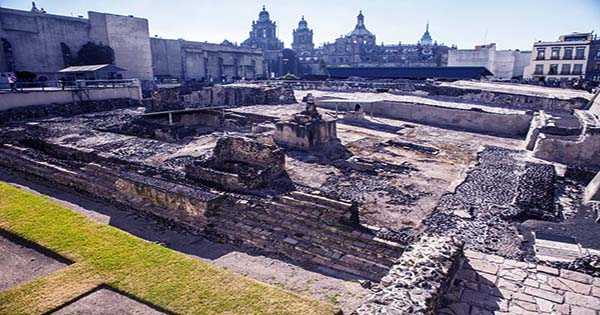A glittering carved relief of gold agglomeration has discovered in the heart of the Aztec Empire’s capital. Archaeologists from the National Institute of Anthropology and History (INAH) in Mexico discovered the relief carved on the igneous rock wall of the Templo Mayor, the central temple of the Aztec city of Tenochtitlan, now in Mexico City. It estimated that the carved slab was part of the floor of this region and used during the reign of Motecuhzoma Ilhuicamina between 1440 and 1469 AD.
The relief originally discovered in February 2020 during the ongoing excavations at the temple ruins, but has since been the subject of further research to find out its significance and deeper meaning.
About 70 temples have found, but it is still the largest, measuring 1 centimeter (3.3 feet) by 70 centimeters (27.6 inches). Along with the size, its significance is also by its location within the temple complex. It was on the central axis that transcends the “chapel” of Huitzilopochtli, the god of war and the sun, and the memorial sculpture of Coyolxauhqu, the goddess of the moon or the Milky Way.
“This floor is unique among the entire Templo mayors because it has base-relief which proves the dual concept of the building. To the south, where we are exploring, there are elements like this agglomerate, associated with the mythical cycle of the birth of Huitzilopochtli; to the north, base-reliefs precede – Leopoldo Batteries first in 1900. And later the PTM and the Urban Archaeological Program (PAU) have presentations related to the regeneration of the Tláloc, the water cycle, and the corn,”explained Rodolfo Aguilar Tapia, archaeologist at the INAH’s Templo Mayor Project, in a statement.
“This is a very beautiful piece that shows the great mystery that the Mayor of the Templeton Temple of Mexico has not yet revealed to us,” commented Alexandra. Frausto Guerrero, head of the Mexican Culture Secretariat.
This relief clearly shows that the Aztecs had a deep cultural connection with the gold agglomeration. Within the city of Teotihuacan, archaeologists had earlier unearthed the bones of eagles, which probably kept as captive animals and probably used for the worship of God. The Aztec army also featured a special class of infantry known as special eagle warriors who equipped themselves with feat eagle feathers and eagle eagle head-shaped headgear.
Last month, INAH archaeologists discovered a bizarre story from the Spanish colony of Mexico, an Aztec-allied city. Using their new archaeological evidence and pre-existing historical accounts, they believe that their discovery shows the place where women and children slaughtered and mutilated by Spanish colonialists. The brutal attack after the atrocities of the previous month by the colonialist parties and their allies was probably an act of revenge.












